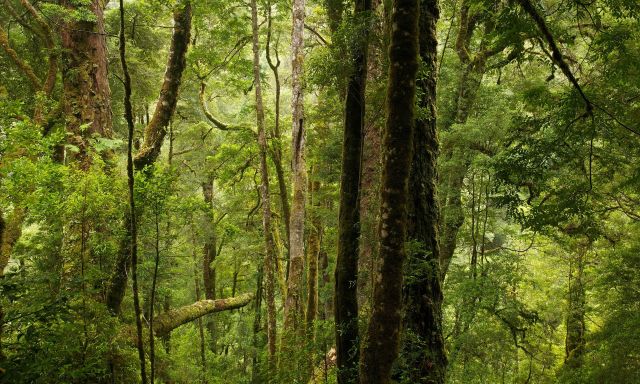
North-western Tasmania is home to one of the world's last remnants of primeval temperate rainforest, part of an ecosystem that once spread across the supercontinent of Gondwana.
Thousand-year-old trees tower above ancient ferns, their roots growing in peat accumulated over millennia. This is why the region has been designated a UNESCO World Heritage Site.
Eucalyptus forests in the rest of Australia need fire to regenerate. But these plants evolved before the cycle of conflagration and renewal began. If they burn they die.
That is why the last pockets of this ancient forest survive high on Tasmania's central plateau where it is too wet for the flames to take hold.
But even that refuge is being destroyed by climate change.
Fuelled by extremely dry conditions over the past two years, more than 100 major bushfires ignited by a massive, dry electrical storm have raged across the region, sending a millennia of plant history up in smoke.
One telltale sign of climate change is that these fires were started by storms not people.
Between 1993 and 2003, Tasmania's Parks and Wildlife Service recorded 17 fires that were started by lightning. In the next decade that number almost doubled to 30.
In a fire risk assessment of the world heritage area, the service said lightning fires should no longer be viewed as “natural” because of the influence of climate change. It concluded that lightning fires were now the main threat to the survival of the world heritage area.
Tens of thousands of hectares have burned in the past two weeks. They were sparked by a perfect storm of natural climate events.
El Nino undoubtedly played a role, as it brings hot, dry summers to Tasmania and the eastern part of Australia.
But last year it combined with the Indian Ocean Dipole, also known as the Indian Nino, an irregular oscillation of sea-surface temperatures in which the western Indian Ocean becomes alternately warmer and then colder than the eastern part. The cooling of the eastern Indian Ocean caused Tasmania's usually drenching spring rains to vanish almost completely.
However, rainfall deficit stretches back further than this. The past two years have been the driest 24-month period ever recorded in north-western Tasmania. Since January 2014, almost 1200 millimeters of rainfall — the equivalent of half a year's rain — has failed to appear.
There has also been a downward trend in rainfall over the period 1970 to 2011 across Tasmania, further impacting ecosystems. Projections show a steadily emerging pattern of increased rainfall over Tasmania's coastal regions and reduced rainfall over central Tasmania and in the north-west.
This is the background that has created favourable fire conditions, the likes of which are rarely seen in a rainforest. Temperatures have been 2°C above average all through January, further drying out fuels. All these layers have created extreme fire conditions in a place known more for its extreme rainfall.
David Lindenmayer, a professor of ecology and conservation biology at the Australian National University in Canberra said: “Clearly the fire regime is starting to change. We are going to see more fires, over larger areas, that are more frequent and of higher severity. What we are seeing in Tasmania would appear to be a manifestation of that.”
When the fires die down, north-western Tasmania will have a vastly different landscape. Stands of King Billy and pencil pine have already been burnt to the ground and Australia's only winter deciduous tree, the Nothofagus, or southern beech, may now be extinct in Tasmania.
Seed Bank coordinator James Wood said it would be possible to replant ancient plant species feared destroyed in the fire. Just last year, during a rare flowering, the Seed Bank collected thousands of seeds from native confiers.
"The seeds themselves germinate very readily for most of these species, but actually getting establishment can be tricky because there's a lot of grazing pressures," he said.
Replanted forests would likely need to be fenced off to prevent them being grazed off by native animals before they could be established.
But Wood said the forests would never be as they were. "You're talking about several decades before you're really going to return to the sorts of picturesque landscapes like the Walls of Jerusalem," he said.
These trees have spent millions of years adapting to slow climate changes. But the current rate of change is unlike anything the world has seen in millions of years.
Temperatures could rise by up to 5°C by the end of the century if human greenhouse gas emissions are not slowed. That rate would be faster than the climate has changed in at least 65 million years and would leave not just Tasmania but the rest of the world's ecosystems forced to cope with a radical new normal.
Like the article? Subscribe to Green Left now! You can also like us on Facebook and follow us on Twitter.